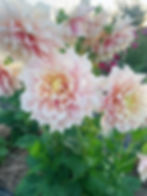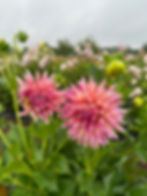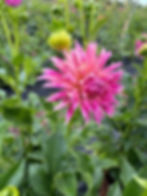
Dahlia Tubers
2025-2026 Dahlia Tuber Sales Are OPEN!!!
Bring the color and beauty to your flower beds and home at an affordable price! At Macks Creek farm, we grow over 2500 tubers each season and have 140 unique varieties. We are excited about our new tuber offerings for 2026. We have also eliminated a few varieties that did not make the cut when looking at growing habits and tuber quality. Following some easy growing instructions will allow you to experience and enjoy the awesome color and beauty of dahlias!
One free mystery tuber for every 5 purchased!
OUR GUARANTEE: If you have any problems with our tubers, call Stephanie or Greg direct any time and we will make it right!
Growing Tubers
Dahlia is a member of the Asteraceae family, which also includes the sunflower, daisy, chrysanthemum, zinnia, and aster.
People all around the world are inspired from the first bloom to the last. Put a row of dahlias on any border and you will be amazed. They make amazing cut flowers.
Dahlias love moist, moderate temperature climates. They are not well suited to extremely hot climates (such as southern Florida or Texas). Dahlias brighten up any sunny garden with a growing season that’s at least 120 days long.
The tubers are planted in the ground in late spring. They are considered a tender perennial in colder regions of North America. They are reliably winter hardy in hardiness zones 8 to 11, although gardeners in zones 6 and 7 may have luck keeping them in the ground as well. In colder zones, dahlias can either be treated as annuals or dug up after the first frost and stored indoors for winter.
Growing in Pots:
Medium- to dwarf-size dahlias do well in containers that have drainage and are big enough to support the plant at maturity. Generally, a 10 to 12 inch diameter container will work well.
-
Use a good potting soil for the pots.
-
Plant 4-5 inches deep.
-
Cover the tuber with a few inches of soil mix.
-
Spray water on the soil to dampen it but then do not water again until the dahlia sproyt breaks the surface.
-
Fertilize through summer with a low nitrogen fertilizer. If you have too much nitrogen you will get tall plants with few blooms.
-
Add soil to the 4-5 inch depth level.
Growing in gardens and flower beds:
When dahlias are established, water 2 or 3 times a week and more in hot, dry climates. Be prepared to tend to plants before or after rain. Large, open blooms tend to fill up with water or take a beating from the wind.
-
Dahlias start blooming about 8 weeks after planting, usually by mid-July.
-
Dahlias benefit from the occasional application of a low-nitrogen, liquid fertilizer, such as 5-10-10 or 10-20-20. Fertilize after sprouting and then every 3 to 4 weeks from midsummer until early autumn.
-
Note: Do not over fertilize, especially with nitrogen, or you risk small or no blooms, weak tubers, or rot.
-
-
When plants are about 10-12 inches tall, you can choose to pinch out the center growth at the center branch to encourage bushier plants and increase stem count and stem length. There are pros and cons either way but both pinching or not pinching is good either way!
-
For large flowers, try disbudding. Remove the two smaller buds next to the central one in a flower cluster. The plant will put all of its energy into fewer but considerably larger flowers.
-
Bedding dahlias typically do not need staking or disbudding. Simply pinch out the center shoot just above the third set of leaves to encourage bushiness. However, if there is no wind protection and you plant tall varieties staking may be required.
-
For more blooms, deadhead as flowers fade.
Greg’s simple winning planting approach!
-
Buy a bag of composted compost and some bone meal.
-
Dig a 5-6 inch deep hole.
-
Add two large handfuls of compost to the hole and a tablespoon of bone meal.
-
Mix it all up with the soil in the bottom.
-
Lay the tuber with the eye facing up in the hole. If you break off the eye the tuber will grow but it may take a while to come up.
-
Cover to 3-4 inches and do not water until it is 1-2 inches tall.






































